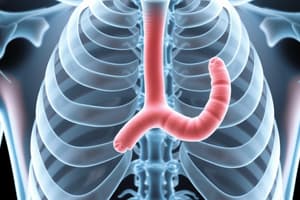Podcast
Questions and Answers
What is the primary cause of primary hyperparathyroidism?
What is the primary cause of primary hyperparathyroidism?
- Benign growths in the parathyroid glands (correct)
- Excessive production of thyroid hormone
- Kidney disease
- Vitamin D deficiency
Which of the following is a potential complication of hyperparathyroidism?
Which of the following is a potential complication of hyperparathyroidism?
- Hypothyroidism
- Liver disease
- Anemia
- Osteoporosis (correct)
What is the main difference between primary, secondary, and tertiary hyperparathyroidism?
What is the main difference between primary, secondary, and tertiary hyperparathyroidism?
- The severity of the condition
- The underlying cause (correct)
- The symptoms experienced
- The treatment options
What is the first-line treatment for primary hyperparathyroidism?
What is the first-line treatment for primary hyperparathyroidism?
Which of the following is a potential risk factor for hyperparathyroidism?
Which of the following is a potential risk factor for hyperparathyroidism?
What is the purpose of medications like cinacalcet in the management of hyperparathyroidism?
What is the purpose of medications like cinacalcet in the management of hyperparathyroidism?
What is the primary cause of secondary hyperparathyroidism (HPT)?
What is the primary cause of secondary hyperparathyroidism (HPT)?
Which of the following is a common cause of secondary HPT?
Which of the following is a common cause of secondary HPT?
How can secondary HPT be managed?
How can secondary HPT be managed?
What is the primary characteristic of tertiary HPT?
What is the primary characteristic of tertiary HPT?
What is the primary focus of treatment strategies for tertiary HPT?
What is the primary focus of treatment strategies for tertiary HPT?
Flashcards are hidden until you start studying
Study Notes
Understanding Hyperparathyroidism
Overview
Hyperparathyroidism (HPT) refers to a group of disorders characterized by excessive secretion of parathyroid hormone (PTH) from one or more of the four parathyroid glands. The overproduction of PTH leads to increased levels of calcium in the blood, known as hypercalcemia, which can impact various bodily functions and increase the risk of complications such as osteoporosis, kidney stones, and cardiovascular disease.
There are three types of HPT: primary, secondary, and tertiary. Primary HPT involves the parathyroid glands themselves, whereas secondary and tertiary forms occur as a result of underlying conditions affecting kidney function or the production of vitamin D.
Diagnosis and Management
Diagnosing HPT requires identifying the source of the excessive PTH secretion and managing any underlying conditions. Treatment options include surgical removal of the affected gland(s), medications to lower PTH levels, and lifestyle modifications to manage associated risks.
Primary HPT
In primary HPT, the parathyroid glands become overactive due to benign growths called adenomas or the growth of additional glands, known as hyperplasia. Surgery, usually involving the removal of some or all of the parathyroid tissue, is often the first-line treatment for primary HPT. Medications like cinacalcet may also be prescribed to help control PTH levels.
Secondary HPT
Secondary HPT occurs when the parathyroid glands receive inaccurate information from other organs, leading to excessive PTH secretion. Common causes include chronic kidney disease, low levels of vitamin D, or an imbalance in the ratio of calcium to phosphorus in the blood. Treating the underlying condition, such as dialysis for kidney disease, can help resolve secondary HPT.
Tertiary HPT
Tertiary HPT develops when remodeling of the parathyroid glands occurs in response to prolonged secondary HPT, resulting in overproduction of PTH even after the underlying condition has been treated. Treatment strategies for tertiary HPT focus on managing the consequences of persistent hypercalcemia, such as preventing bone loss and reducing the risk of associated complications.
Regardless of the type of HPT, early detection and appropriate management can help prevent or minimize associated complications and improve quality of life.
Studying That Suits You
Use AI to generate personalized quizzes and flashcards to suit your learning preferences.




